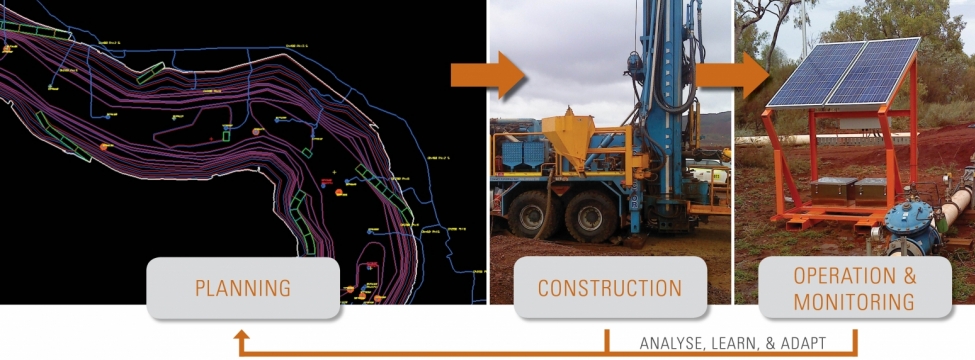When it comes to dewatering and depressurisation at operational mine sites, getting the technical understanding right is only half the story. The other key to success is in maintaining and operating equipment effectively, as well as dealing with a constantly evolving mine environment. The best dewatering or depressurisation system in the world will only be as effective as the way it is operated. If pumps are down for maintenance, refuelling, or damage from mining, they will quickly become limiting factors to success. Furthermore, the system must stay relevant throughout the inevitable changes in mine design that come as a mine moves through the development cycle.
Dewatering and depressurisation planning should be integrated with the many mining disciplines which it interacts with or it will fail. However, these interactions, and the operational decisions that result, should be well informed with timely, reliable, operations specific monitoring data. Good data may require significant cost and effort but good mine water management decisions will almost certainly deliver many times more value back. Data capture need not be complex but the consistency and quality of the data requires a well-designed monitoring plan with clear justification for every measurement, honing in on key risk areas. This not only enables the monitoring and subsequent analysis to be as cost-efficient as possible, but also prevents dilution of key messages from “data overload.”
Presenting data in an easy-to-understand format that can quickly inform discussions and tactical changes is also paramount. Problem solving should proceed logically from aquifer response to abstraction rate to equipment effectiveness using universally understood metrics. For example, if groundwater levels are higher than planned, but abstraction rates achieve plan, then the conceptual hydrogeological model should be investigated; but if abstraction rates, availability, and utilisation are all lower than plan, infrastructure maintenance would come into question.
Should we wait until the operational stage of a mine to consider these challenges? Dewatering and depressurisation planning and operation is an iterative process that follows the typical Plan-Do-Check-Act cycle, necessarily taking data and learnings from construction and operation as an input into the next plan iteration. Although this seems like a simple concept, often systems are designed in a one-off, linear way so that changes in hydrogeological understanding, mine plans, or operational efficiency render the system ineffective. If systems are not phased, flexible, and unobtrusive from the outset, these mistakes can be extremely costly to correct once built. Innovative solutions to avoid mining interactions, like angled wells, horizontal directional drilling, and targeted pre-blasting, may cost more initially but can often reap significant financial benefits over the project life.
Understanding the challenges of dewatering and depressurisation upfront can produce flexible solutions that integrate seamlessly with operations, are easy to operate and maintain, and ultimately reduce costs and maximise dewatering or depressurisation effectiveness.

